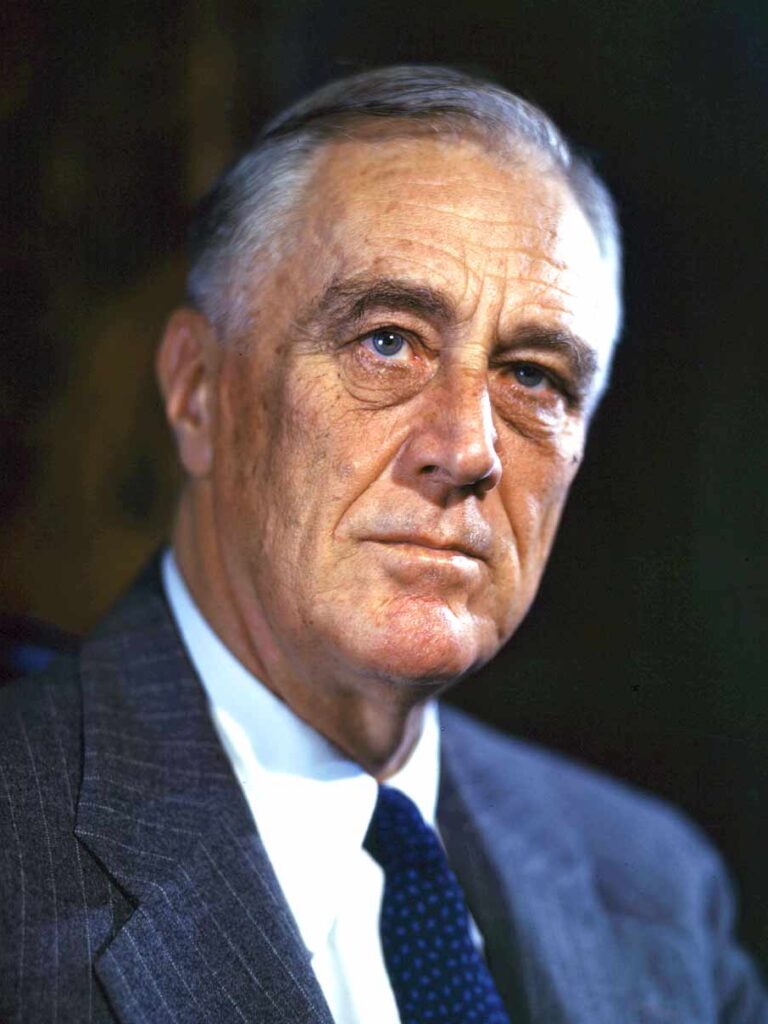Franklin Delano Roosevelt, FDR, or Franklin D Roosevelt is usually rated as one of the leading U.S. Presidents of facts together with Abraham Lincoln, George Washington, and a few more. He was the longest-serving president in the history of the United States successfully documenting 4 presidential elections and serving from 1933 to 1945. His indelible mark on both domestic and international fronts is a testament to his statesmanship and resilience in times of crisis. His role in the formation of the United Nations and his multifaceted approach to governance in New York laid the groundwork for transformative policies that shaped the trajectory of American history.
Franklin D Roosevelt (32nd US President) Interesting Facts
Franklin D. Roosevelt’s presidency unfolds as a captivating narrative of resilience, innovation, and global leadership. From the depths of the Great Depression to the zenith of World War II, FDR’s indelible mark on history endures through his multifaceted New Deal, transformative domestic policies, and statesmanship on the world stage. As we delve into the complexities of Roosevelt’s legacy, his ten major accomplishments and strategic role in global affairs emerge as enduring testaments to a leader who navigated the nation through its darkest hours with sagacity and fortitude.
1. FDR’s Rise Amidst Despair and the New Deal
The ascension of Franklin D. Roosevelt to the presidency marked a pivotal moment in American history, coinciding with the depths of the nation’s most severe economic downturn – the Great Depression. As he assumed office, the country was ensnared in the throes of unprecedented economic turmoil, teetering on the brink of collapse. Roosevelt, however, emerged as a beacon of hope and resilience, orchestrating a multifaceted strategy known as the New Deal. This groundbreaking initiative aimed not merely at economic recovery but also encompassed relief for the suffering masses and comprehensive reforms to prevent a recurrence of such cataclysmic financial crises.
FDR’s indomitable spirit and visionary policies steered the nation away from the abyss of despair. His multifaceted approach, involving relief programs to alleviate immediate suffering, recovery measures to revive the economy, and systemic reforms to ensure lasting stability, showcased a statesmanship that transcended the ordinary. Through a series of legislative initiatives, Roosevelt reshaped the American social and economic landscape, leaving an enduring impact that resonates to this day.
2. Architect of Global Victory: FDR and World War II
Beyond the domestic arena, Franklin D. Roosevelt assumed a pivotal role in navigating the United States through the tumultuous waters of World War II. The global conflict posed an existential threat, with the Axis Powers menacingly expanding their dominion. In this perilous scenario, Roosevelt’s leadership proved indispensable, as he adeptly guided America to become a formidable force in the fight against tyranny.
FDR’s influence extended far beyond the confines of his nation. His strategic acumen and diplomatic finesse forged alliances that were instrumental in the defeat of the Axis Powers. Roosevelt’s commitment to the principles of democracy and freedom became a rallying point for nations united against the forces of oppression. His speeches, including the iconic “Four Freedoms,” resonated globally, inspiring countless individuals to join the collective effort for a world liberated from the shackles of totalitarianism.
3. Unveiling the Tapestry of FDR’s Ten Major Accomplishments
Delving into the rich tapestry of Franklin D. Roosevelt’s legacy reveals a mosaic of ten major accomplishments that have solidified his status as one of America’s greatest presidents. From the landmark Social Security Act, which transformed the nation’s approach to social welfare, to the establishment of the Civilian Conservation Corps, a monumental initiative addressing both unemployment and environmental conservation, FDR’s presidency left an indelible imprint on the nation’s fabric.
The expansion of labor rights, the introduction of the Works Progress Administration, the Banking Act of 1933, and the creation of the Tennessee Valley Authority stand as testaments to Roosevelt’s transformative governance. These accomplishments not only addressed immediate challenges but also laid the groundwork for a more equitable and resilient American society. In navigating the country through the crucible of the Great Depression and World War II, FDR’s legacy endures as a testament to leadership in the face of adversity.
13. FDR’s Role in World War II: A Statesman’s Odyssey
A closer examination of Franklin D. Roosevelt’s role in World War II unveils a statesman’s odyssey marked by strategic brilliance and geopolitical finesse. As the storm clouds of war gathered, Roosevelt navigated the treacherous diplomatic waters, forging alliances and mobilizing resources to confront the Axis Powers. His mastery in balancing military strategy with international diplomacy positioned the United States as a linchpin in the grand coalition against tyranny.
FDR’s wartime leadership was not confined to military strategy alone. His vision extended to the post-war world, where he played a pivotal role in shaping the foundations of the United Nations. The Atlantic Charter, a joint declaration with Winston Churchill, laid the groundwork for a global order built on principles of peace, security, and self-determination. Thus, Roosevelt’s legacy transcends the battlefield, encompassing a vision for a world order that would emerge from the ashes of conflict.
- 140 Interesting Facts About Madonna
- 142 Interesting Facts About Justin Bieber
- 35 Interesting Facts about Victor Hugo
- 60 Interesting Facts About Robert De Niro
- 40 Alfred Nobel Interesting Facts for All Ages
- 22 Interesting Facts About Kelli Williams
- 32 Interesting Facts About Woody Allen
- 25 Uma Thurman Important Facts
- Christopher Columbus Important Facts
- Sir Walter Raleigh Facts to Know about A Legend
- 37 Interesting Facts about Pablo Picasso
- 30 Interesting Facts About Frank Sinatra
- 18 Interesting Facts About George Clooney
- 20 Interesting Facts About Katy Perry
- 28 Interesting Facts About Demi Moore’s Bio
- 35 Interesting Facts About Novak Djokovic
- Rishi Kapoor – Biography | Movies | Achievements
- Irrfan Khan – Biography | Contribution | Achievement
- 75 John Lennon Interesting Facts
- 58 Drew Barrymore Interesting Facts for Fan

